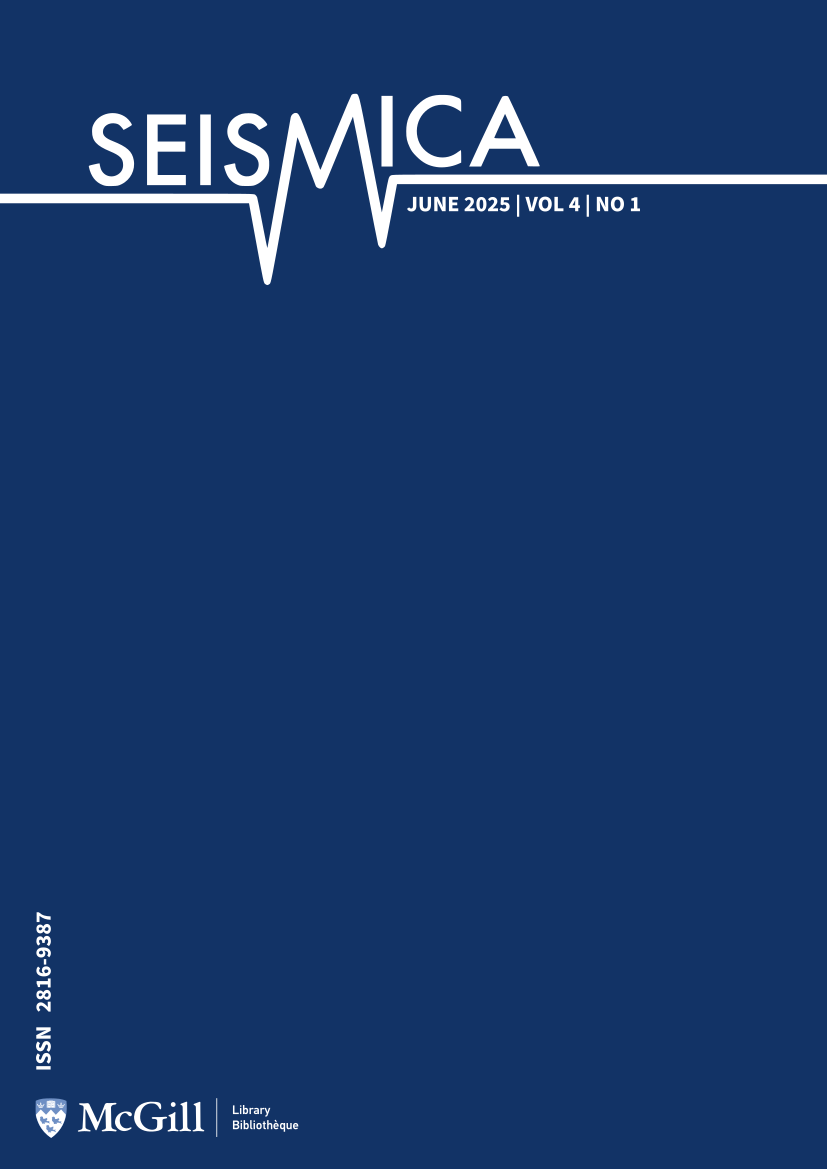Revising the Seismic Ground Truth Reference Event Identification Criteria
DOI:
https://doi.org/10.26443/seismica.v4i1.1536Keywords:
Ground Truth Seismicity, Azimuthal Station CoverageAbstract
Accounting for improvements in the location algorithms used to relocate seismic events, we investigate the criteria used to identify well constrained seismic event locations, particularly seismic Ground Truth events. By relocating explosions with known epicentres using modern location techniques, we have determined that the parameter measuring unbalanced station distributions, ΔU, can be replaced by a more general measure of azimuthal station coverage defined as the Cyclic Polygon Quotient. This is the ratio of the area of a cyclic polygon formed by connecting event to station azimuths on a unitary circle, and the area of the unitary circle. We demonstrate that the semi-major axis of the error ellipse after relocation is a strong discriminant of location quality. We show that hypocentre depth can be resolved where multiple seismic stations report both P & S phase arrivals, providing an alternative to the previous Ground Truth identification criteria, which requires a station within 10 km of the event. These findings are incorporated into an updated set of criteria for identifying well constrained seismic event locations. We show that the updated criteria increases both the number and geographic distribution of Ground Truth events that can be added to the IASPEI Reference Events List.
References
Begnaud, M. L., Myers, S. C., Young, B., Hipp, J. R., Dodge, D., & Phillips, W. S. (2020). Updates to the Regional Seismic Travel Time (RSTT) Model: 1. Tomography. Pure and Applied Geophysics, 178(7), 2475–2498. https://doi.org/10.1007/s00024-020-02619-5
Belinić, T., & Markušić, S. (2017). Empirical criteria for the accuracy of earthquake locations on the Croatian territory. Geofizika, 34(1), 1–17. https://doi.org/10.15233/gfz.2017.34.5
Bennett, T. J., Oancea, V., Barker, B. W., Kung, Y.-L., Bahavar, M., Kohl, B. C., Murphy, J. R., & Bondar, I. K. (2010). The Nuclear Explosion Database (NEDB): A New Database and Web Site for Accessing Nuclear Explosion Source Information and Waveforms. Seismological Research Letters, 81(1), 12–25. https://doi.org/10.1785/gssrl.81.1.12
Bergman, E. A., Benz, H. M., Yeck, W. L., Karasözen, E., Engdahl, E. R., Ghods, A., Hayes, G. P., & Earle, P. S. (2022). A Global Catalog of Calibrated Earthquake Locations. Seismological Research Letters, 94(1), 485–495. https://doi.org/10.1785/0220220217
Bittner, P., Le Bras, R., Mialle, P., & Nielsen, P. (2022). International Data Centre Bulletin Events Triggered by Controlled Underwater Explosions of World War 2 Ordnances. Pure and Applied Geophysics, 180(4), 1303–1315. https://doi.org/10.1007/s00024-022-03146-1
Bondár, I., Engdahl, E. R., Yang, X., Ghalib, H. A. A., Hofstetter, A., Kirichenko, V., Wagner, R., Gupta, I., Ekström, G., Bergman, E., Israelsson, H., & McLaughlin, K. L. (2004). Collection of a Reference Event Set for Regional and Teleseismic Location Calibration. Bulletin of the Seismological Society of America, 94(4), 1528–1545. https://doi.org/10.1785/012003128
Bondar, I., & McLaughlin, K. (2009). Seismic Location Bias and Uncertainty in the Presence of Correlated and Non-Gaussian Travel-Time Errors. Bulletin of the Seismological Society of America, 99(1), 172–193. https://doi.org/10.1785/0120080922
Bondár, I., & McLaughlin, K. L. (2009). A New Ground Truth Data Set For Seismic Studies. Seismological Research Letters, 80(3), 465–472. https://doi.org/10.1785/gssrl.80.3.465
Bondár, I., Yang, X., North, R. G., & Romney, C. (2001). Location Calibration Data for CTBT Monitoring at the Prototype International Data Center. Pure and Applied Geophysics, 158(1), 19–34. https://doi.org/10.1007/pl00001155
Bondár, István, Bergman, E., Engdahl, E. R., Kohl, B., Kung, Y.-L., & McLaughlin, K. (2008). A hybrid multiple event location technique to obtain ground truth event locations. Geophysical Journal International, 175(1), 185–201. https://doi.org/10.1111/j.1365-246x.2008.03867.x
Bondár, István, Godoladze, T., Cowgill, E., Yetirmishli, G., Myers, S. C., Gunia, I., Buzaladze, A., Czecze, B., Onur, T., Gök, R., & Chiang, A. (2023). Relocation of the Seismicity of the Caucasus Region. Bulletin of the Seismological Society of America, 114(2), 857–872. https://doi.org/10.1785/0120230155
Bondár, István, Myers, S. C., Engdahl, E. R., & Bergman, E. A. (2004). Epicentre accuracy based on seismic network criteria. Geophysical Journal International, 156(3), 483–496. https://doi.org/10.1111/j.1365-246x.2004.02070.x
Bondár, István, & Storchak, D. (2011). Improved location procedures at the International Seismological Centre. Geophysical Journal International, 186(3), 1220–1244. https://doi.org/10.1111/j.1365-246x.2011.05107.x
Boomer, K. B., Brazier, R. A., & Nyblade, A. A. (2010). Empirically Based Ground Truth Criteria for Seismic Events Recorded at Local Distances on Regional Networks with Application to Southern Africa. Bulletin of the Seismological Society of America, 100(4), 1785–1791. https://doi.org/10.1785/0120090237
Braden, B. (1986). The Surveyor’s Area Formula. The College Mathematics Journal, 17(4), 326–337. https://doi.org/10.1080/07468342.1986.11972974
Gomberg, J. S., Shedlock, K. M., & Roecker, S. W. (1990). The effect of S-wave arrival times on the accuracy of hypocenter estimation. Bulletin of the Seismological Society of America, 80(6A), 1605–1628. https://doi.org/10.1785/bssa08006a1605
Kennett, B. L. N., & Engdahl, E. R. (1991). Traveltimes for global earthquake location and phase identification. Geophysical Journal International, 105(2), 429–465. https://doi.org/10.1111/j.1365-246x.1991.tb06724.x
Kennett, B. L. N., Engdahl, E. R., & Buland, R. (1995). Constraints on seismic velocities in the Earth from traveltimes. Geophysical Journal International, 122(1), 108–124. https://doi.org/10.1111/j.1365-246x.1995.tb03540.x
Sweeney, J. J. (1996). Accuracy of teleseismic event locations in the Middle East and North Africa. Office of Scientific. https://doi.org/10.2172/514441
Sweeney, J. J. (1998). Criteria for selecting accurate event locations from NEIC and ISC bulletins (p. 130655). Lawrence Livermore National Laboratory.
Zeng, X., Xie, J., & Ni, S. (2014). Ground Truth Location of Earthquakes by Use of Ambient Seismic Noise From a Sparse Seismic Network: A Case Study in Western Australia. Pure and Applied Geophysics, 172(6), 1397–1407. https://doi.org/10.1007/s00024-014-0993-6
Zhu, C., Wang, C., Zhang, B., Qin, X., & Shan, X. (2021). Differential Interferometric Synthetic Aperture Radar data for more accurate earthquake catalogs. Remote Sensing of Environment, 266, 112690. https://doi.org/10.1016/j.rse.2021.112690
Downloads
Additional Files
Published
How to Cite
Issue
Section
License
Copyright (c) 2024 Ryan Gallacher, Tom Garth, James Harris, István Bondár, Keith McLaughlin, Dmitry A. Storchak

This work is licensed under a Creative Commons Attribution 4.0 International License.



